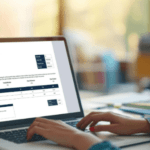Manual audits aren’t just slow—they’re a liability. Every missing receipt, late approval, or inconsistent payment record opens the door to fraud, regulatory trouble, and financial waste. As 2025 unfolds, finance leaders are done tolerating the inefficiencies of manual AP audits.
At the forefront of finance automation trends is AP audit digitisation, now recognised as a top priority across industries. The reason is simple: digitisation offers speed, accuracy, and control that outdated processes just can’t match. This blog explores why AP audit digitisation has become non-negotiable—and how it’s transforming finance teams into strategic powerhouses.
The Hidden Costs of Manual AP Audits

Manual processes may feel familiar, but they come at a steep price. Teams spend hours collecting invoices, emailing for approvals, and reconciling discrepancies—when they should be analysing trends and supporting decision-making.
The lack of real-time visibility and standardisation introduces opportunities for error and fraud. What’s more, compliance suffers when documentation is fragmented or missing. These inefficiencies not only drain productivity but also increase exposure to financial and reputational risks.
Real-Time Visibility Improves Financial Control

With digitised AP audit trails, financial information becomes accessible, searchable, and transparent. Instant access to invoice statuses, approval timelines, and payment records allows teams to identify issues before they snowball.
One global logistics provider saw a 60% reduction in audit preparation time after digitising AP. Dashboards now surface anomalies in real-time, eliminating the need to sift through emails or folders during an audit cycle.
Key benefits of real-time AP audit data:
- Immediate detection of duplicate entries and discrepancies
- Shorter audit prep cycles with fully searchable records
- Easier forecasting through live spend insights
- Reduced audit-related stress across departments
AI Brings Intelligence to Auditing

In 2025, audit digitisation is about much more than scanning documents. AI technologies are elevating the process from reactive to predictive. Modern platforms don’t just collect data—they understand it.
AI flags unusual transactions that humans might miss: split invoices designed to bypass approval thresholds, off-hour payments, or vendors invoicing under multiple identities. These alerts allow finance teams to mitigate risks before they impact compliance or financial integrity.
This shift from random sampling to full-spectrum review is a leap forward. It moves audit from a backwards-looking exercise to a forward-looking risk management strategy.
Compliance Demands Are Getting More Complex
As regulatory frameworks evolve, compliance requirements become more nuanced. From e-invoicing mandates to real-time reporting obligations, organisations are under pressure to maintain meticulous records.
Manual systems can’t meet these expectations. Auditors and regulators increasingly expect digitally accessible records with clear audit trails and tamper-proof evidence.
Digitised AP audit systems automatically timestamp approvals, log user actions, and align with global data standards, ensuring readiness for any compliance review.
Compliance-driven benefits of digitisation:
- Tamper-resistant documentation that aligns with international standards
- Fast, accurate evidence retrieval for regulatory inquiries
- Automated policy violation detection
- Better audit outcomes and fewer compliance penalties
Stronger Vendor Relationships Through Transparency
Beyond internal efficiency, AP digitisation strengthens supplier relationships. Delayed payments caused by manual errors often frustrate vendors and strain negotiations. When finance teams have instant access to invoice and payment data, disputes are resolved quickly and fairly.
Suppliers also gain greater visibility into payment timelines, improving trust and reducing the risk of service interruptions. One mid-sized retailer reported a 60% drop in vendor disputes within a year of digitising their AP audit process.
From Transactional to Strategic: AP’s Evolving Role
Traditionally, AP was a transactional function. But digitisation has elevated its role within finance. By unlocking access to clean, real-time spend data, AP teams now support budgeting, forecasting, and financial planning efforts.
This strategic shift also promotes better alignment with procurement, legal, and compliance teams. Together, they can enforce purchasing policies, manage vendor relationships, and reduce maverick spend.
Strategic contributions from digitised AP teams:
- Identification of cost-saving opportunities and spending anomalies
- Real-time budget monitoring with variance analysis
- Enabling proactive vendor management based on performance metrics
- Reducing cycle times to improve cash flow forecasting
Integrating with the Finance Stack
One of the biggest advantages of AP audit digitisation is its ability to seamlessly connect with the broader finance tech ecosystem. Modern platforms are built for integration, enabling end-to-end workflows from procurement to payment.
When integrated with ERP, procurement, and expense systems, data flows without manual entry or duplication. This not only saves time but also reduces risk and strengthens the overall audit trail.
Key integration points:
- ERP systems like SAP, Oracle NetSuite, Microsoft Dynamics
- Procurement tools such as Coupa, Ariba, and Jaggaer
- Expense management platforms like Concur and Expensify
- Document management solutions for secure archival access
Data Security and Access Control
Security is critical when digitising sensitive financial workflows. Leading AP audit platforms prioritise encryption, multi-factor authentication, and role-based permissions.
Every interaction is logged, from approvals to document edits, creating a transparent and verifiable audit trail. This not only ensures regulatory compliance but also discourages internal fraud.
With data privacy laws like GDPR and SOC 2 now standard, digitised AP systems give organisations the control they need to remain compliant and secure.
Sustainability Matters Too
Finance automation has sustainability benefits that are often overlooked. By eliminating the need for paper-based invoices, couriered documents, and physical storage, companies reduce their environmental footprint.
Remote approvals further reduce travel-related emissions. For companies with ESG goals, digitising AP audits is a practical and measurable step toward sustainability.
Environmental gains from audit digitisation:
- Reduced paper consumption and waste
- Lower energy use for physical storage systems
- Fewer emissions from document transport and travel
- Enhanced ESG reporting and compliance
What to Look For in an Audit Digitisation Tool
Selecting the right tool requires evaluating features that go beyond digitising documents. The platform must support intelligent automation, robust integration, and compliance-first design.
Customisable dashboards, AI-driven alerts, and cloud-based scalability are essential. Strong permission controls and detailed activity logs ensure governance across teams.
Critical features to prioritise:
- AI-driven anomaly detection
- Custom KPI dashboards and audit-ready exports
- Integration with ERP and compliance systems
- Secure, role-based access and user activity logs
Final Thoughts: Don’t Get Left Behind
Finance transformation is no longer optional. Companies that continue to rely on manual AP audit processes risk falling behind—operationally, strategically, and competitively.
Digitised AP audits empower teams with insights, speed, and oversight. They unlock the full potential of finance teams, shifting them from transactional gatekeepers to strategic enablers.
If you’re ready to cut costs, reduce risk, and scale confidently, now is the time to digitise your AP audit process.
Call to Action
Want to modernise your AP audit operations in 2025?
Serina.ai can help you automate faster, reduce fraud risk, and give your finance team the clarity it needs to scale.
Reach out today to see how intelligent AP automation can transform your audits for good.
Image Alt-Text: Finance manager reviewing AI-powered AP audit dashboard with invoice timelines and compliance alerts.

